What is the Fastest Growing Vegetable to Harvest?
Key Takeaways
- Radishes are one of the fastest growing vegetables, ready for harvest in as little as 25 days.
- Salad leaves can be harvested in as little as 21 days, making them a great option for quick homegrown salads.
- Bush beans produce tender beans that can be ready for harvest in around 60 days, offering a bountiful harvest in a relatively short time.
Are you eager to start your own vegetable garden but don’t want to wait too long for your harvest? Luckily, there are several vegetables that have a short growth cycle, allowing you to enjoy the fruits (or rather, veggies) of your labor in no time. In this article, we will explore the fastest growing vegetables to harvest, providing you with a comprehensive list of options to consider for your garden.
Radishes
Radishes are often hailed as one of the fastest growing vegetables, and for good reason. These crisp and peppery root vegetables can be ready for harvest in as little as 25 days, making them an excellent choice for impatient gardeners. Whether you prefer the classic red radishes or the milder white or purple varieties, you can expect a quick turnaround with this versatile vegetable.
Salad Leaves
If you’re looking to enjoy fresh greens in your salads as soon as possible, salad leaves are a great option. Typically a mix of different lettuces, arugula, and other leafy greens, salad leaves can be harvested in as little as 21 days. These fast-growing vegetables are perfect for those who want to start enjoying their own homegrown salads in just a few weeks.
Bush Beans
For a bountiful harvest of beans in a relatively short time, consider planting bush beans. These compact plants produce an abundance of tender beans that can be ready for harvest in around 60 days. Whether you prefer green beans or yellow wax beans, bush beans are a great addition to any vegetable garden.
Carrots
Carrots are a popular root vegetable known for their sweet and crunchy taste. While some carrot varieties can take a while to mature, there are baby carrot varieties that can be ready for harvest in just 50 days. These petite carrots are perfect for snacking, adding to salads, or roasting alongside other vegetables.
Spinach
Spinach is a nutrient-rich leafy green that is not only delicious but also quick to grow. Depending on the variety, spinach can be ready for harvest in as little as 30 days. With its versatility and health benefits, spinach is a fantastic addition to any garden.
Conclusion
When it comes to the fastest growing vegetables to harvest, radishes, salad leaves, bush beans, carrots, and spinach are among the top contenders. These vegetables offer a relatively short growth cycle, allowing you to enjoy a bountiful harvest in a matter of weeks. Whether you’re a seasoned gardener looking for quick results or a beginner eager to see the fruits of your labor, these fast-growing vegetables are sure to satisfy.
Related Websites:
FAQs:
Q: Why is it important to know the fastest growing vegetable to harvest?
Knowing the fastest growing vegetable allows you to optimize your gardening efforts and enjoy quicker harvests. It saves you time and effort while providing you with fresh produce sooner.
Q: What factors contribute to the growth rate of vegetables?
The growth rate of vegetables is influenced by factors such as germination time, growth rate, and ideal growing conditions. Germination time refers to how quickly a vegetable’s seeds sprout and develop. Growth rate is the speed at which a vegetable plant reaches maturity. Ideal growing conditions include temperature, sunlight, soil quality, and water.
Q: Which vegetables have fast growth rates?
Some vegetables known for their fast growth include leafy greens like lettuce, spinach, kale, and arugula; radishes with their quick germination and harvest time; microgreens, which are young vegetable greens harvested just after sprouting; and green beans, known for their speedy growth and high yield potential.
Q: How can I cultivate the fastest growing vegetables?
To cultivate fast-growing vegetables, it is essential to choose the right seeds bred for quick growth. Prepare the soil by ensuring it is well-drained and nutrient-rich. Provide regular watering and appropriate fertilization to support rapid growth. Adequate sunlight is also crucial, so ensure the plants receive enough exposure.
Q: Are there other factors to consider for vegetable growth rates?
Yes, there are additional factors to consider. Climate conditions can affect growth rates, so it’s important to adapt to different climates. Seasonality also impacts the growth rate of vegetables. Succession planting, which involves staggered planting, ensures a continuous supply of fast-growing vegetables.






